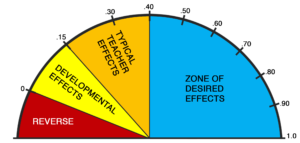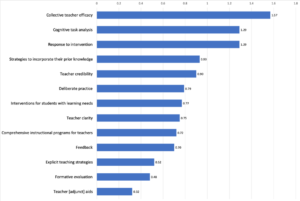QuickSmart recently earned national recognition from Australia’s peak research body, the Australian Research Council, as one of only four projects in the field of education to be awarded the highest impact in all three categories: engagement, impact and approach to impact. The QuickSmart Numeracy and Literacy intervention programs have helped over 60,000 students across Australia since 2001. The national assessment recognised that QuickSmart significantly contributes to strong academic outcomes as well as improved self-esteem for middle-school students with poor basic skills in numeracy and literacy. This article uses John Hattie’s framework for Influences Related to Achievement (2017) and related effect sizes to explore some of the factors that contribute to the program’s success.
Effect size (ES) measures the effect of one particular educational practice relative to another. ES also gives an indication on the expected efficacy of a practice or intervention. Hattie determined an effect size of 0.4 to be the average effect, so this ‘hinge-point’ became the invisible line between typical effect and high effect. Practices with effect sizes above 0.4 should be considered as highly effective (Fig 1).

Figure 1: The meaning of effect sizes: teachers should aim for influences with an effect size of 0.4 or above. Image: Adapted from visible-learning.org (Hattie 2017).
Teachers are constantly challenged with narrowing the gap between the lowest achievers and the ‘average’ achievers in their classroom. Differentiation is an effective and excellent teaching approach, but when the achievement gap is large, differentiation may not be enough. While teacher aides (Fig 2, ES 0.32) often work with low-achieving students, the effect often remains below the zone of desired effects (Fig 1). School funds could be better placed in an intervention program that targets students’ individual needs.
Interventions for students with learning needs (Fig 2, ES 0.77) can have high impact on student outcomes. QuickSmart is a comprehensive instructional program (Fig 2, ES 0.72) that equips teachers with resources and comprehensive training in strategies and instructional models to use with their students. Trained QuickSmart instructors measure their students’ response to intervention (RTI) (Fig 2, ES 1.29) using observations and the diagnostic tools provided. While the lessons are structured, the program is designed to be flexible, so that instructors consistently work with the students at each student’s pace and level. QuickSmart aims to close the achievement gap so that students reach a point where they can independently sustain growth.

Figure 2: Effect sizes according to influence. Image: Excerpt from 252 Influences And Effect Sizes Related To Student Achievement (Hattie 2017).
Students start their QuickSmart lessons at their own individual level. Experiencing success at the start of the program boosts their self-esteem and confidence, and builds rapport between the instructor and student. Gradually, students are given strategies to incorporate their prior knowledge (Fig 2, ES 0.93) to learn new number facts or words. They learn to use these strategies with deliberate practice (Fig 2, ES 0.79) throughout the QuickSmart lessons. Students receive immediate feedback (Fig 2, ES 0.70) on their performance, both by the instructor and the computer-based diagnostic formative evaluation (ES 0.48) tool used in the lessons. The goal is to achieve automaticity in their basic skills, which enables them to move on to higher-order tasks like problem solving. Cognitive task analysis (CTA) (Fig 2, 1.29) refers to the process of teaching students how to think and problem solve. In each lesson students explicitly learn to find patterns in number facts and words, until it becomes second nature. Students become fluent (quick) and efficient (smart) with words or number facts.
Extensive professional development is a key feature of QuickSmart. Each instructor attends six days of training throughout the school year, during which they learn to use the resources and the language they need to be clear (Fig 2, ES 0.75) and explicit (Fig 2, ES 0.52) in their teaching. Instructors become confident in their skills and firm in the belief that they can make a difference to their students’ learning. Lessons are consistent and coherent, and each instructor (ideally) works with the same two students each lesson, which builds trust. All of these factors contribute to teacher credibility (Fig 2, ES 0.90). This is a student’s belief that they can learn from a particular teacher, because the teacher is trustworthy and convincing, and they believe in the student’s success.
This brings us to the final influence on our list; collective teacher efficacy (Fig 2, ES 1.57). At the core of it all is the understanding that teachers have an effect on student achievement, that the effect is positive, and that it is not dependent on current attainment levels. A strong evidence base, a research-driven approach and school-based evidence of effect fuel the belief in making a difference.
QuickSmart includes one further influence on positive outcomes: time. Students who are years behind in their numeracy and/or literacy need time to close the gap. In order for new learning to occur, and new neural pathways to be firmly formed, students should attend 90 or more 30 minute QuickSmart lessons over a year. Data gathered during the intervention shows that students often experience the most growth in the final stages of the program, when everything comes together. Therefore, a school’s decision to invest in a learning intervention program needs to be part of a long-term plan to lift student outcomes.
To find out more about the QuickSmart programs, visit our website.
Disclaimer: QuickSmart is a not-for-profit product of the SiMERR National Research Centre at the University of New England, and it is not financially connected to Visible Learning.
Do you have an idea for a story?Email [email protected]
 Education Review The latest in education news
Education Review The latest in education news

